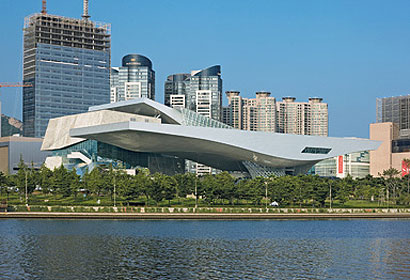|
|
||
|
Of all the baby-boomer architects, those who passed through university in the late 1960s, the firm that still seems most consistently in touch with its roots is Coop Himmelb(l)au of Vienna. Wolf D Prix, the one remaining founder of the firm from its inception in 1968, is known for his confrontational public pronouncements – most recently giving the Venice Biennale a dressing down for being “hollow, arduous, exhausting, bleak and boring” – and Coop Himmelb(l)au’s architecture still exhibits an irreverence that is now lacking in the work of some of its peers. Recently it has completed the Busan Cinema Centre in South Korea. On the one hand, this building is yet another large, extravagant cultural bauble; on the other, it is remarkable for being so true to the spirit of the firm’s early experiments and provocations. The building is a home for the Busan International Film Festival, one of Asia’s most important film events. It comprises three main elements, each given a bucolic moniker – a cluster of fairly regular buildings (hills) contain the programme, which includes cinemas, theatres and a media centre for the film festival. A large public space (valley) surrounds these buildings, and sailing over it all are two signature Coop-Himmelb(l)au roofs (sky): massive steel space frames creating inverted landscapes that float heavily above the space beneath. The roof itself contains programme, and its voluptuous underside is installed with LEDs, allowing the entire building to become an animated screen in itself.
The dispersal of different parts of the project across the site is in keeping with Coop Himmelb(l)au’s tendency to design via juxtapositions of massive elements, but it also allows for the creation of a large open public space: the “valley”. “It’s very important to give the ideas a place,” Prix says. “How would people congregate if only in the virtual space?” Like many, Prix feels that genuine public spaces (so necessary for social change, as Tahrir Square and the Occupy moment have recently demonstrated) are in decline across the world, and that part of his job is to promote and create them. “In former times, the church, the nobles, and the rich bourgeois built and maintained the public space,” he explains. “Now, the cities don’t have money any more, so we have to find a new strategy – and sponsors.” In the BMW Welt building, the car manufacturer created such a space, but it was branded and so effectively remained a huge showroom. But the space under the roof in Busan takes this publicness further, with the prospect of it being used in a more open-ended manner. “You know the roof is an architectural element, basically for protection?” says Prix, enthusiastically showing off images and videos of the project. “We didn’t know when we did this project here in London [The House with the Flying Roof, 1973, a partly demolished terraced house with a dirigible apparently lifting the roof into the sky] that we were interested in this thing. But it developed, and step by step we developed the roof as an element of meaning.” From their legendary 1987 rooftop remodelling in Old Vienna, there’s been a consistent development of Coop Himmelb(l)au’s ideas of roofscape, right up to the BMW Welt building in Munich, the obvious precursor to the current project. In Busan, though, it has reaching a sophisticated level: videos show the building animated, a bright rainbow one second, disappearing into the night the next. Heavy it might be, but at the same time it can’t help but remind one of all the data-bubbles and inflatables of yesterday’s dreams. The Busan Cinema Centre is certainly not revolutionary, being after all just another large cultural building of the sort we’ve become pretty jaded about by now. But one can really sense a trace of the idealism and generosity of spirit that motivated radical designers in the past to picture flamboyant, weightless, public buildings, scenes of free collective events and gatherings, changing colour and appearance at will. It raises the question – where can this mode of design go from here? “The next stage?” says Prix: “No building!” |
Image Duccio Malagamba
Words Douglas Murphy |
|
|
||



















